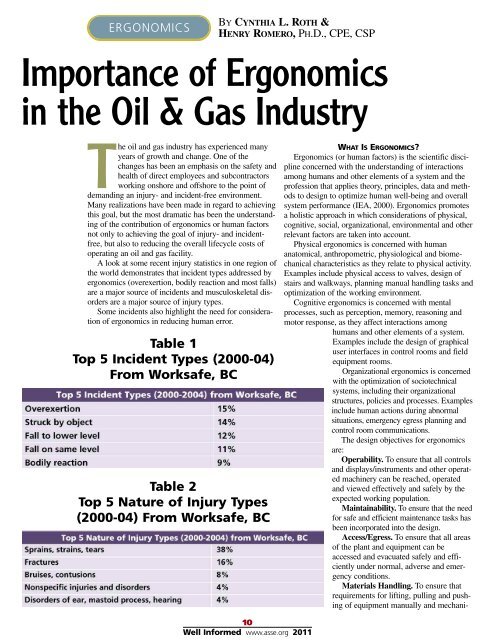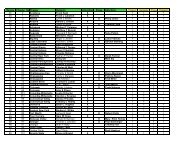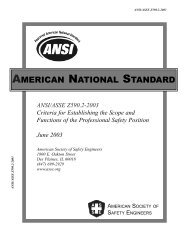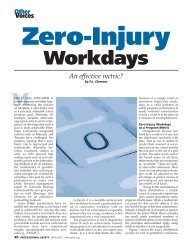OSHA's Flame-Resistant Clothing Policy - ASSE Members
OSHA's Flame-Resistant Clothing Policy - ASSE Members
OSHA's Flame-Resistant Clothing Policy - ASSE Members
Create successful ePaper yourself
Turn your PDF publications into a flip-book with our unique Google optimized e-Paper software.
ERGONOMICSBY CYNTHIA L. ROTH &HENRY ROMERO, PH.D., CPE, CSPImportance of Ergonomicsin the Oil & Gas IndustryThe oil and gas industry has experienced manyyears of growth and change. One of thechanges has been an emphasis on the safety andhealth of direct employees and subcontractorsworking onshore and offshore to the point ofdemanding an injury- and incident-free environment.Many realizations have been made in regard to achievingthis goal, but the most dramatic has been the understandingof the contribution of ergonomics or human factorsnot only to achieving the goal of injury- and incidentfree,but also to reducing the overall lifecycle costs ofoperating an oil and gas facility.A look at some recent injury statistics in one region ofthe world demonstrates that incident types addressed byergonomics (overexertion, bodily reaction and most falls)are a major source of incidents and musculoskeletal disordersare a major source of injury types.Some incidents also highlight the need for considerationof ergonomics in reducing human error.Table 1Top 5 Incident Types (2000-04)From Worksafe, BCTable 2Top 5 Nature of Injury Types(2000-04) From Worksafe, BCWHAT IS ERGONOMICS?Ergonomics (or human factors) is the scientific disciplineconcerned with the understanding of interactionsamong humans and other elements of a system and theprofession that applies theory, principles, data and methodsto design to optimize human well-being and overallsystem performance (IEA, 2000). Ergonomics promotesa holistic approach in which considerations of physical,cognitive, social, organizational, environmental and otherrelevant factors are taken into account.Physical ergonomics is concerned with humananatomical, anthropometric, physiological and biomechanicalcharacteristics as they relate to physical activity.Examples include physical access to valves, design ofstairs and walkways, planning manual handling tasks andoptimization of the working environment.Cognitive ergonomics is concerned with mentalprocesses, such as perception, memory, reasoning andmotor response, as they affect interactions amonghumans and other elements of a system.Examples include the design of graphicaluser interfaces in control rooms and fieldequipment rooms.Organizational ergonomics is concernedwith the optimization of sociotechnicalsystems, including their organizationalstructures, policies and processes. Examplesinclude human actions during abnormalsituations, emergency egress planning andcontrol room communications.The design objectives for ergonomicsare:Operability. To ensure that all controlsand displays/instruments and other operatedmachinery can be reached, operatedand viewed effectively and safely by theexpected working population.Maintainability. To ensure that the needfor safe and efficient maintenance tasks hasbeen incorporated into the design.Access/Egress. To ensure that all areasof the plant and equipment can beaccessed and evacuated safely and efficientlyunder normal, adverse and emergencyconditions.Materials Handling. To ensure thatrequirements for lifting, pulling and pushingof equipment manually and mechani-10Well Informed www.asse.org 2011












